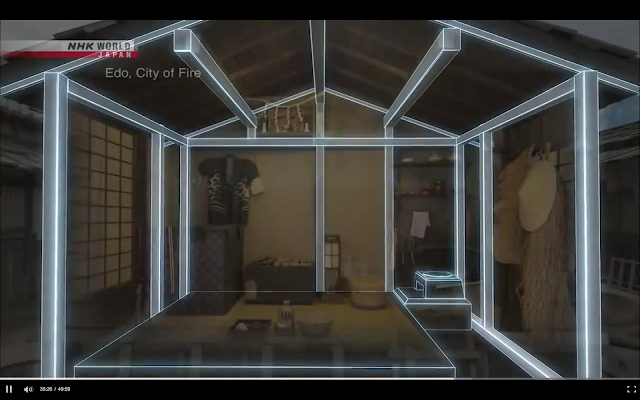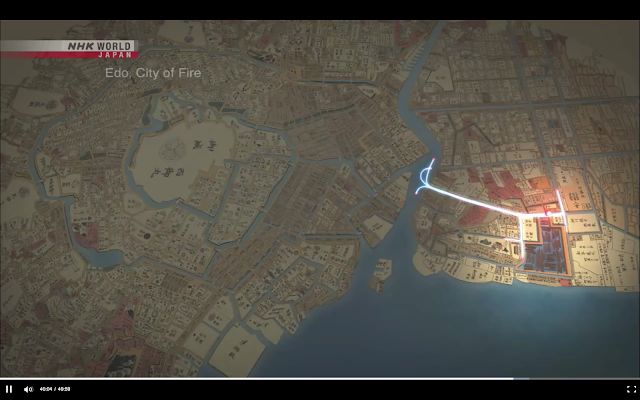Edo, the predecessor of modern Tokyo before the Japan's Meji Reform in the late 19th century, is the former capital city of Japan from 16th to 19th century. It is also a period marked in Japanese history. This period is almost an equivalence of Tudor England where great minds of arts and literal works were formed and the cities and towns were all built of timbers. The three hundreds years of Edo Japan is frequently ravaged by fires and the design of fire prevention and city reconstruction were mostly laid down to ease the modern day city big disasters. Edo has lifted its construction technology by referencing how London reconstructed from the Great Fire in 1666 with City Reconstruction Act mandating the use of brick and two and half brick thick wall. This marked a great leap of Japan urban construction in Meji Period where Tokyo were suddenly dominated by brickworks.
Edo is constantly ravaged by fires in an average of three years during its three centuries history. The fire went across the neighborhood through the fire tornados. Reconstructed scene made by NHK.
Palaces and Temples in Edo's Tokyo were also in no exception of frequent fires leading Japanese's craftsmanship of heritage restoration techniques with specified construction timber codes and how it is passed down reconstruction with minimal period of time and practice. (NHK)
Unearthed artifacts of the urban construction site near Tokyo Train Station complex reveals the burned surface of timber still piled up layer by layer as the future foundations of later houses. (NHK)
Edo's commoners household were built with rather simple timber frame without much of the decoration as they understand the need for quick reconstruction in the events of frequent fires in the urban neighborhood. (NHK)
Identification of Fire layer and Laid earth for the Edo period houses during the archaeology dig through the construction site near Tokyo Train Station. (NHK)
The red layers of archaeology dig to the ground suggested the layer of fire during Edo's Tokyo, at the construction site near Tokyo Train Station. It reveals a very frequent fire events. (NHK)
The Edo's Tokyo has built a storage of timbers near the current day Fish Market as a means of quick supply for reconstruction from frequent urban fires. (NHK)
Transportation of supplied reconstruction timbers and raw materials through a network of water canals in Edo's Tokyo. (NHK)
Great Fire of London in 1666 is a key event modernising London through reconstruction act with viable construction materials and codes.
Reconstructed Edo's Tokyo with urban fabrics made of entirely flammable timber houses and facilities. (From NHK)
The Meji Period of Japan is a resemble of Victorian Britain where great innovation took place as well as great growth of nation's power. However, this brick urban landscape did not withhold with the fires in Grand Kando Earthquakes in 1923 but with the fire rescue built by common spirit shaped through centuries of Edo People.
NHK Documentary: https://www3.nhk.or.jp/nhkworld/en/ondemand/video/4001319/
Palaces and Temples in Edo's Tokyo were also in no exception of frequent fires leading Japanese's craftsmanship of heritage restoration techniques with specified construction timber codes and how it is passed down reconstruction with minimal period of time and practice. (NHK)
NHK好劇推薦-江戶-火災之城
在1875年日本明治維新之前,東京叫做江戶,在長達250年的江戶年代,城市居住單位節琳比次,火災吞食整城的劇碼頻繁的發生,ㄧ般家戶都用傳統木柱木板與紙窗施作,而且非常璞實而無太多裝飾,從考古挖掘出的民居地基甚至是已經被薰黑的木板,木造之都的江戶,平均每三來年都來ㄧ次的火災吞噬,人民並不是幹話連篇,從古畫中發現,大火之後都區居民是微笑的,因爲,又來了,又可以幫社區重建,甚至發展成驅火與重建的祭典舞蹈。
城市有念及整座城市需不斷快速重建,除了佈滿城的水道做防火區間與運送要徑之外,甚至在今天魚市築地市場處開挖鄰海的木板木材大型存置巢與米糧存置巢,來讓城市頻繁的重建可以順利發生,而且市民家戶甚至發展出類似火災保險的概念,那保險理陪的就是存在築地市場附近的重建木料。
你可以說江戶人家真的好笨,怎麼ㄧ直讓火災吞食整城的劇情不斷的發生,不能將住宅單位區隔遠ㄧ點嗎,街道寬ㄧ點,灑水設施多一點,甚至不要用木材不就行了嗎?但從許多過去江戶火災現場發現的都是火風爆,就是俗稱火龍捲風,迅速會把火苗跨區引入,然候木造而居住構造平坦無巨樓的都市模型就成火苗陪養皿。
Edo's Tokyo first documented Meireki Great Fire took place in 1657, nine years before 1666 London Great Fire. (NHK)Dr Johnson's House is one of the first houses rebuilt after the 1666 London Great Fire with reconstruction made entirely from bricks and thick walls of 2.5 bricks that withstands the blowing of the fire flames, (NHK) It is a revolution of urban landscape of fire resistant not just in London but also in the East Asia's Singapore and Hong Kong and where Meji Reform of Japan were brought to, mainly in Taiwan.
但木材造屋乃是日本文化與精神象徵,死人才住石頭屋以下,而且在明治維新時代之前只有發展出火災救難與預防措施,而不是徹底改變日本住屋文化,直到英國人帶進紅磚文化,ㄧ個在1666年倫敦大火之後產生的建築規範,規定用可迅速生產製造的紅磚而不是之前都鐸年代的木構與茅草屋,房子與房子的區隔,公園與花園間隔,磚牆的外牆厚度等等防火法律,終將倫敦打造成防火之都,而日本也看到了紅磚的好處,就把會蓋紅磚的英國匠師挖過來東京,他就是康得,雖然紅磚暫時解決木屋易燃的本質,1923年東京大地震整城又燃起來,解決方案仍是三百年來江戶所衍發的防火救難與重建機制。
Vacant quarter in the aftermath of frequent fires in Edo's Tokyo older maps suggests the fire partition gradually took shape in the event of fire prevention practice in urban quarters.
Smiling faces among the Edo's people in the old painting of Japan suggests a time of rejuvenation, rebirth of city life and growth. (NHK)
















Comments
Post a Comment